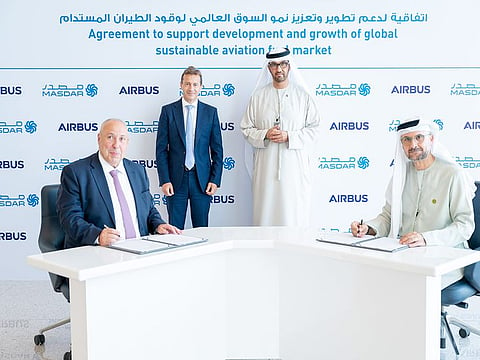Abu Dhabi’s Masdar, Airbus join forces to promote sustainable energy sources in aviation
Agreement will support implementation of ‘book and claim’ solutions for SAF

Abu Dhabi: Abu Dhabi’s Masdar has signed an agreement with Airbus to promote development of the sustainable aviation fuel (SAF) market.
The agreement also covers green hydrogen and direct air capture technologies and support the implementation of ‘book and claim’ solutions. The latter process enables airlines to purchase SAF without being geographically connected to a supply site.
Dr. Sultan Ahmed Al Jaber, UAE Minister of Industry and Advanced Technology, Chairman of Masdar and COP28 President-Designate, was there at the signing along with Guillaume Faury, CEO of Airbus, and Mohamed Jameel Al Ramahi, CEO of Masdar.
Al Ramahi said, “This MoU with Airbus amplifies Masdar’s commitment to accelerating the reduction of global carbon emissions and pioneering worldwide efforts towards decarbonisation.”
According to Precedence Research, the global SAF market is expected to grow to over $14 billion by 2032. SAF is an immediately available solution for reducing CO2 emissions in global air transportation. It can be used as a drop-in fuel without modifying existing storage and refuelling infrastructure, aircraft, or engines.
Mikail Houari, President of Airbus Africa and Middle East, said, “We have a legacy of successful collaborations in the UAE that has contributed to advancing the country’s aerospace sector capabilities. This agreement will support advancing its (SAFs) much-needed development and growth.”
Earlier this year, Masdar announced that its initiative focusing on green hydrogen to produce SAF is working with licensors to certify a new production pathway for SAF from methanol.
What are direct air capture technologies?
These enable capturing atmospheric carbon dioxide, which could, in combination with hydrogen, be used to produce synthetic SAF. The use of SAF based on green hydrogen and direct air capture is estimated to reduce greenhouse gas emissions by up to 95 per cent compared to conventional jet fuel.
Sign up for the Daily Briefing
Get the latest news and updates straight to your inbox



